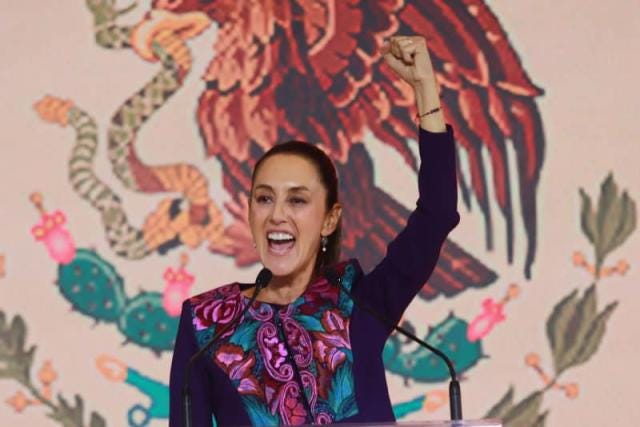La Presidenta: Mexico's Election
Claudia Sheinbaum becomes Mexico's first female leader. How did that happen and what's in store for her — and Mexico?
There was nothing really surprising about the results of Mexico’s election on Sunday. Two women were on the ballot, so the country was bound to have its first female leader. Claudia Sheinbaum, a Nobel winning climate scientist and most recently mayor of Mexico City, had been polling several percentage points ahead of her rival, Xóchitl Gálvez, a computer engineer specializing in robotics and an entrepreneur. Sheinbaum comfortably edged out Gálvez by about 30 points, with nearly 60 percent of the vote.
The question I’ve been asking is: How did Mexico end up with two women on the ballot for the highest office, just 71 years after suffrage?
Yeah, Mexico granted women the right to vote in 1953. (There are currently two places in the world where women do not have suffrage, Vatican City and Eritrea).
Mary Beth Sheridan and Lorena Rios asked that same question in The Washington Post. It all comes down to activism, electoral reform, and timing. “As in other parts of Latin America, when a wave of authoritarian governments crumbled in the 1980s and 1990s, activists sold the idea that real democracy meant equal participation for women,” they write.
Following the end of single party rule in 2000, when the Institutional Revolutionary Party, known by the initials PRI, lost after 71 years in power, women’s groups increased their push for increased female participation in politics. In 2002, as Jennifer Piscopo writes, Mexico adopted a 30 percent gender quota, albeit with loopholes. Women would be included on ballots, but they could then be removed arbitrarily. In 2008, as election laws were being reformed, women successfully pushed for the quota to be increased to 40 percent. A number of women were elected into office, but many were forced to give up seats to men. That sparked a backlash. Piscopo writes:
Prominent women leaders came together, forming a network of politicians, journalists, academics, activists and policymakers known as Mujeres en Plural (Women as Multiple). Together, they brought a class-action lawsuit before Mexico’s federal electoral court, which has final say over election law.
The court, led by then chief magistrate María del Carmen Alanis, appealed to the equal rights enshrined in Mexico’s constitution. Alanis explained the court’s reasoning: “Gender equality is a constitutional principle equal to other constitutional principles.” In other words, gender equality cannot play second fiddle to other constitutional principles, like political parties’ freedom to choose candidates. The court wrote that each party must nominate men and women in “equality of conditions” and that the quota needed to be filled “without exception.
This landmark ruling tied the gender quota to fulfilling Mexico’s constitutional promise of gender equality. Parties lost their loopholes. Soon after, the 2014 constitution reform replaced the 40 percent gender quota with gender parity for the federal Congress and the state legislatures. The 2015 electoral reform added that parties could not send women candidates exclusively to losing districts.
In 2019, Mexico passed a constitutional amendment on gender parity.
In her victory speech, Sheinbaum noted that she would become the first woman president of Mexico, in the country’s 200 year history. This Economist podcast, notes that, “it’s not exactly clear what kind of history” Sheinbaum herself will make. “Her win is less about her credentials than those of her predecessors, Andrés Manuel López Obrador, AMLO.”
AMLO tapped Sheinbaum to serve as environment minister when he was Mexico City’s mayor back in 2000. Completing his sixth and final year in office1, he once again turned to Sheinbaum to succeed him. Indeed, as Pamela Starr noted on Newshour, that made Sunday’s election one about continuity versus change.
It has also led many to wonder if she will be AMLO’s puppet or blaze her own path. Frida Gittis notes that the two are distinct individuals, with differing styles and priorities. Where AMLO is a “charismatic populist,” she’s a pragmatic scientist, who is committed to the environment, Gittis writes. (I bet Mexico City residents, who are incurring water shortages, are curious about that credential.)
Whatever path Sheinbaum takes, it will not be an easy one. Crime and gang violence are at an all-time high in Mexico. As of May 24, 34 political candidates were assassinated across the country leading up to the June 2 vote. Femicide is another pressing issue. An average of 10 women are murdered per day in Mexico. Not surprisingly, migration and the economy are other top priorities, both involving the United States.
Shannon O’Neil writes that as Mexico’s next leader, Sheinbaum will have to contend with the intractable problems on the border as well as trade issues not only with the US, but China. Mexico has replaced China as America’s largest trading partner ($900 billion), for numerous reasons, namely proximity. That has prompted a number of Chinese companies to set up shop in Mexico, in the hopes of getting their goods across the border. No bueno, say many in the US. How Sheinbaum navigates that amid Mexico’s financial constraints, a crumbling infrastructure, and growing gang violence and insecurity will certainly test her abilities. You bet we’ll be watching. — Elmira
Editorial Team
Elmira Bayrasli - Editor-in-Chief
Editors:
Pin-Shan Lai
Catherine Lovizio
Emily Smith
Mexican presidents only serve one six-year term.





